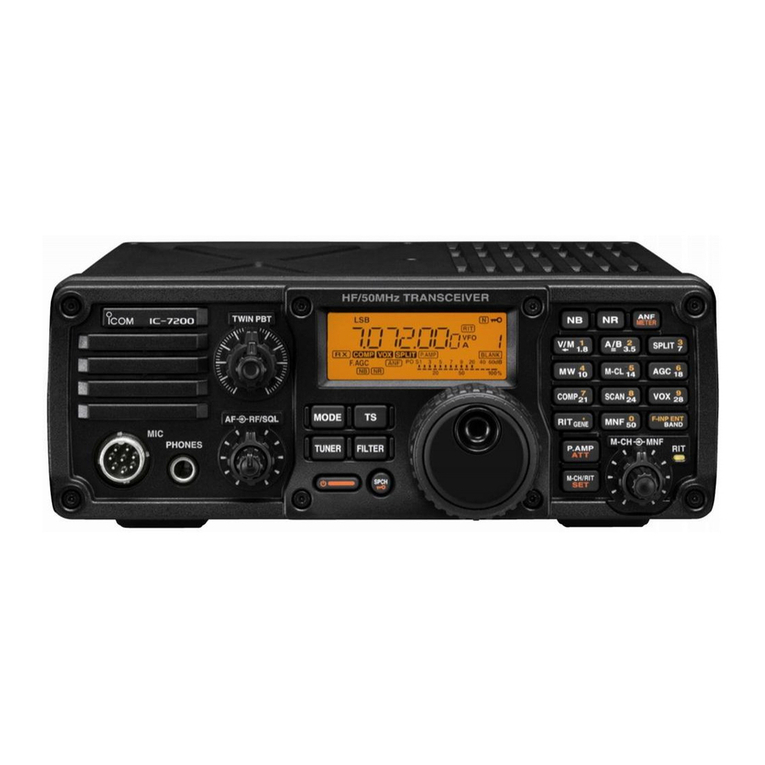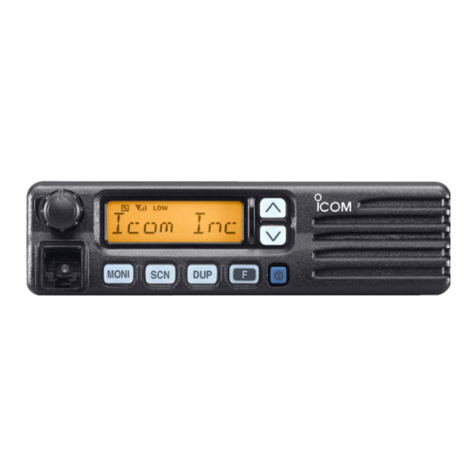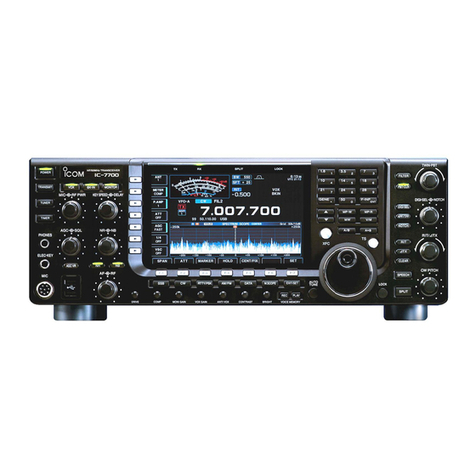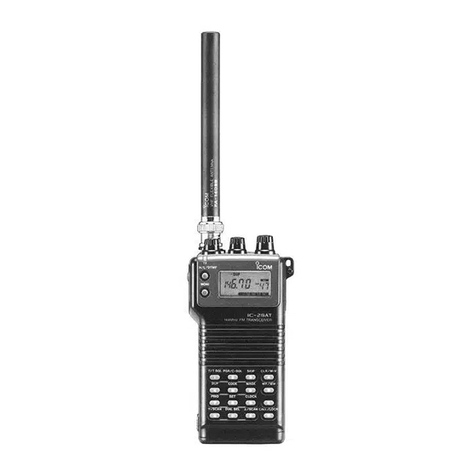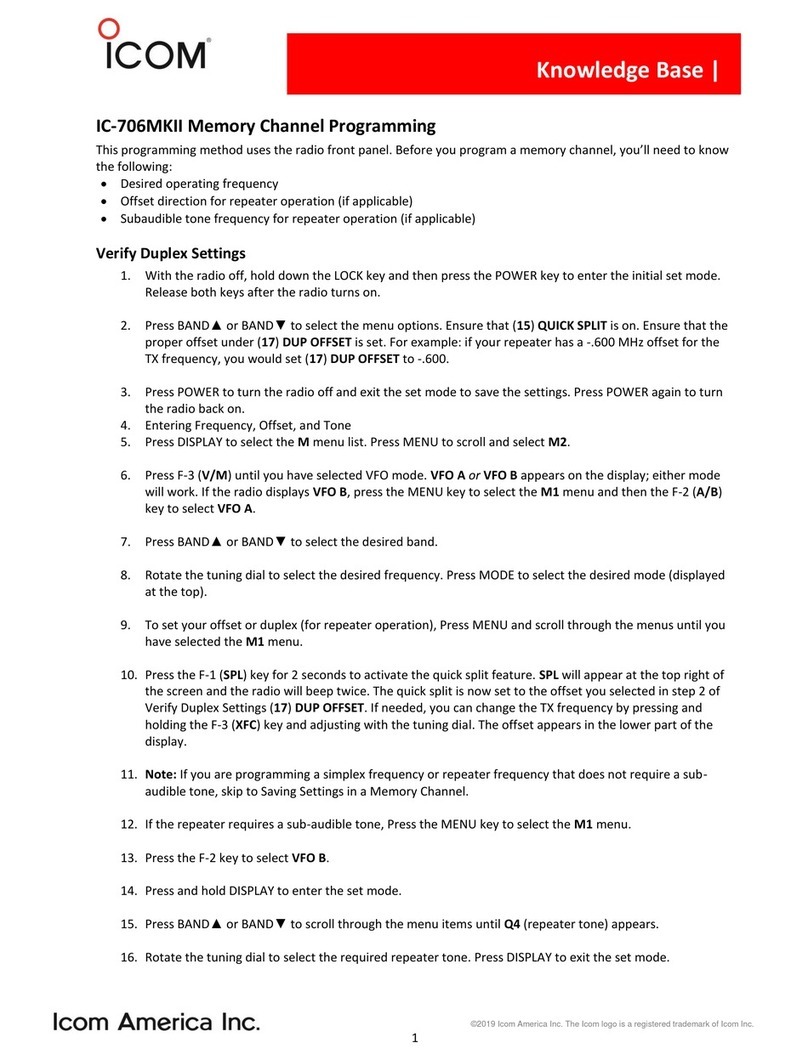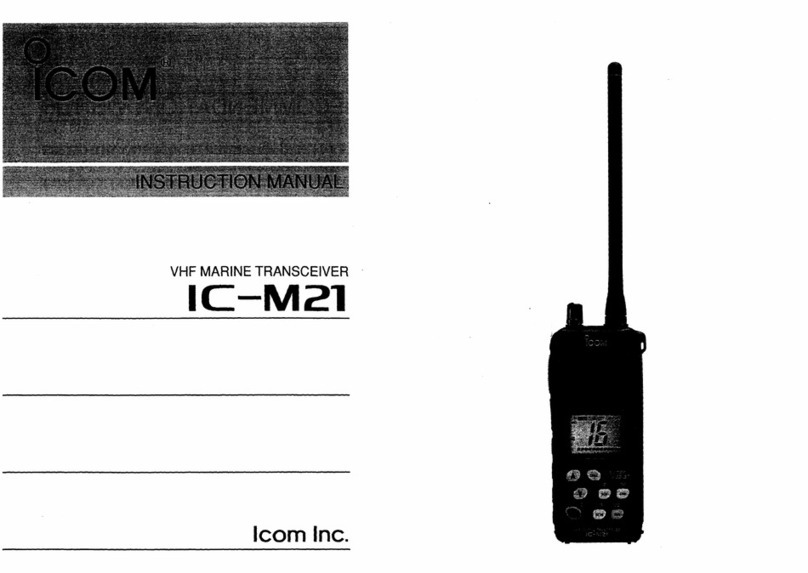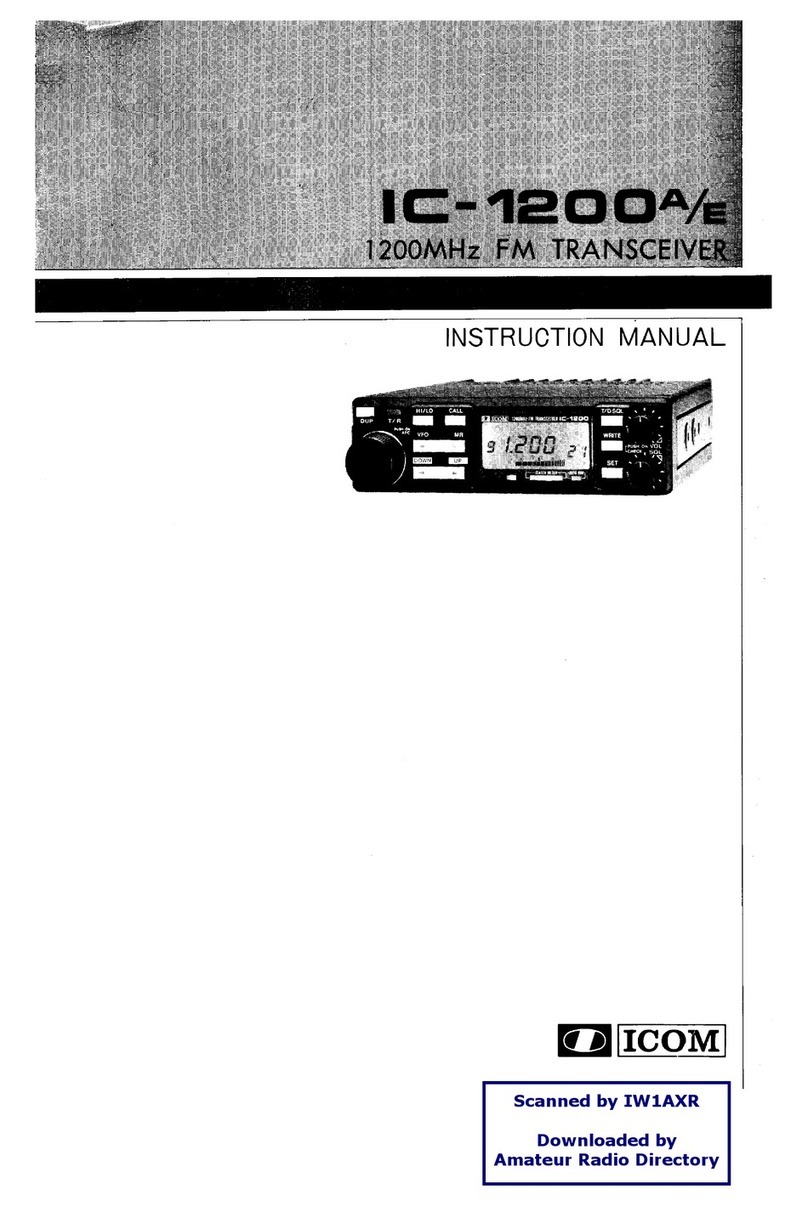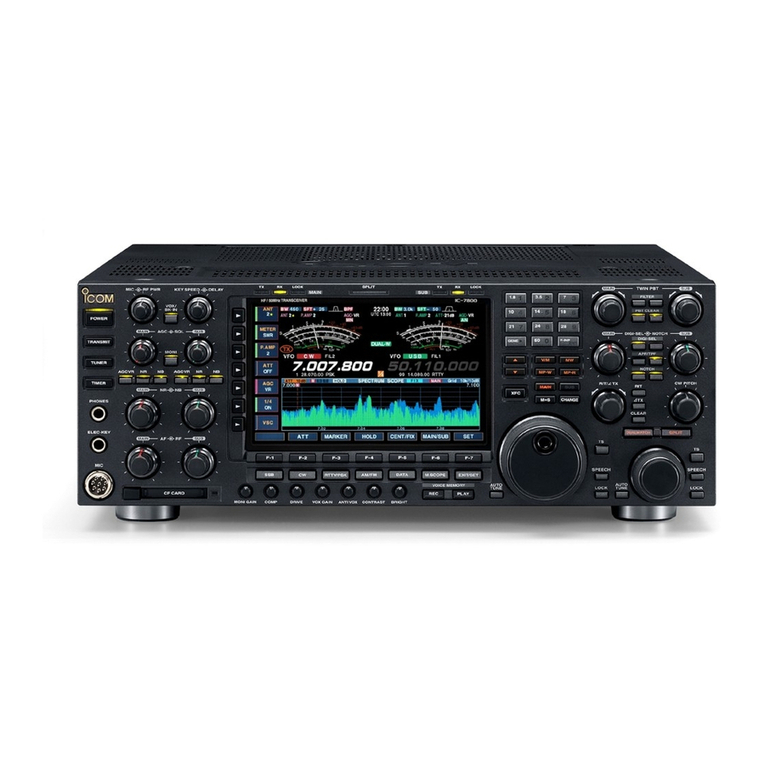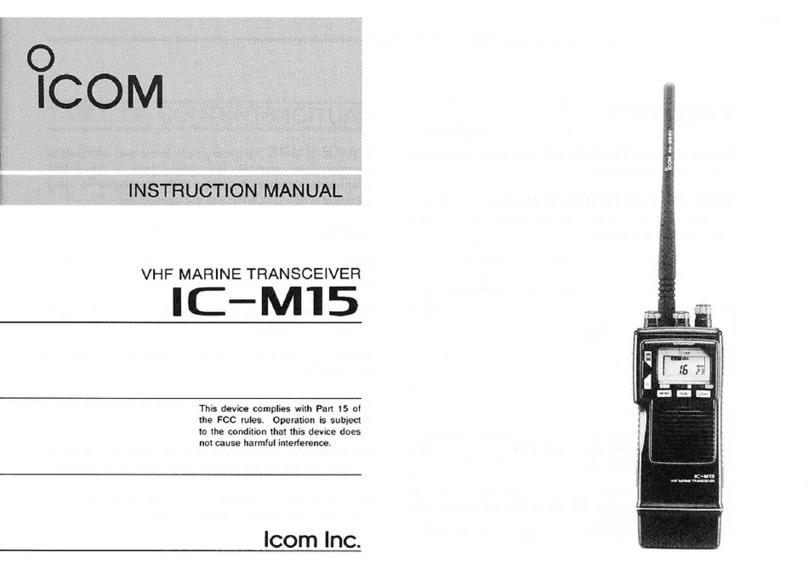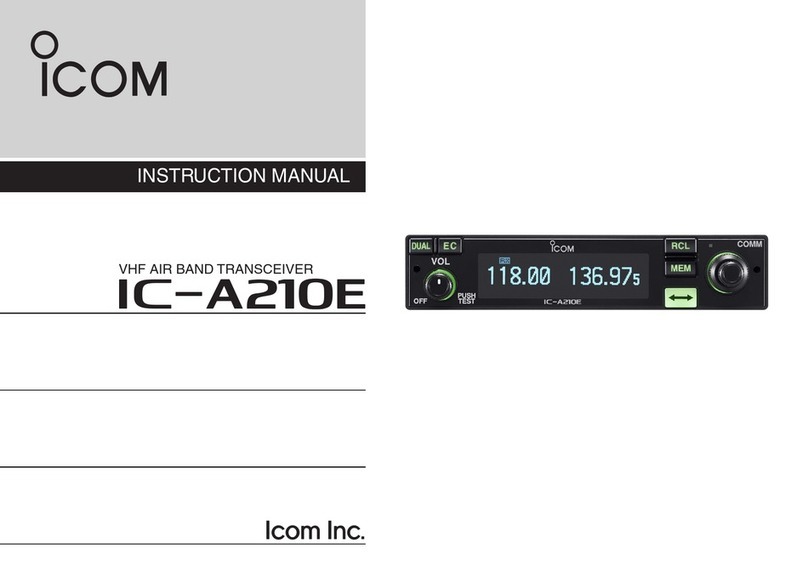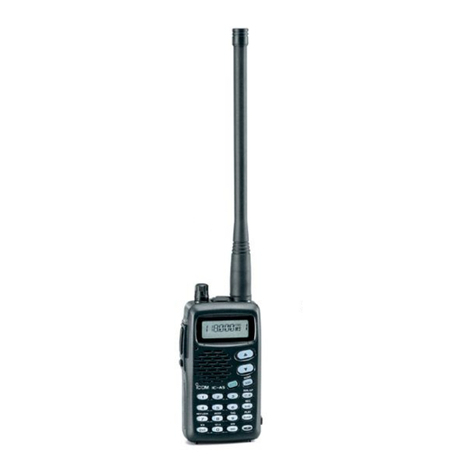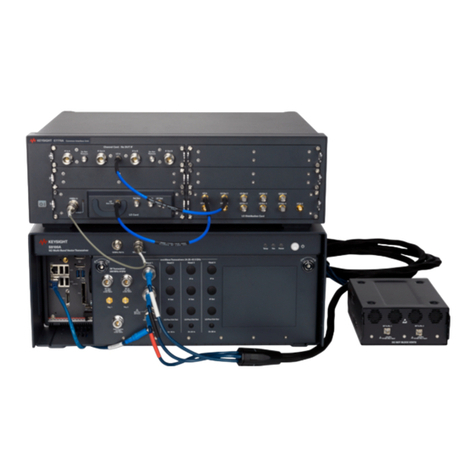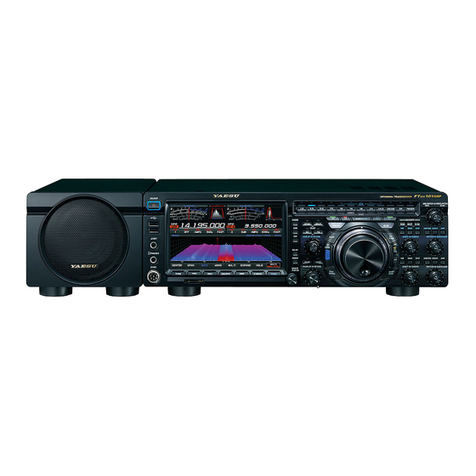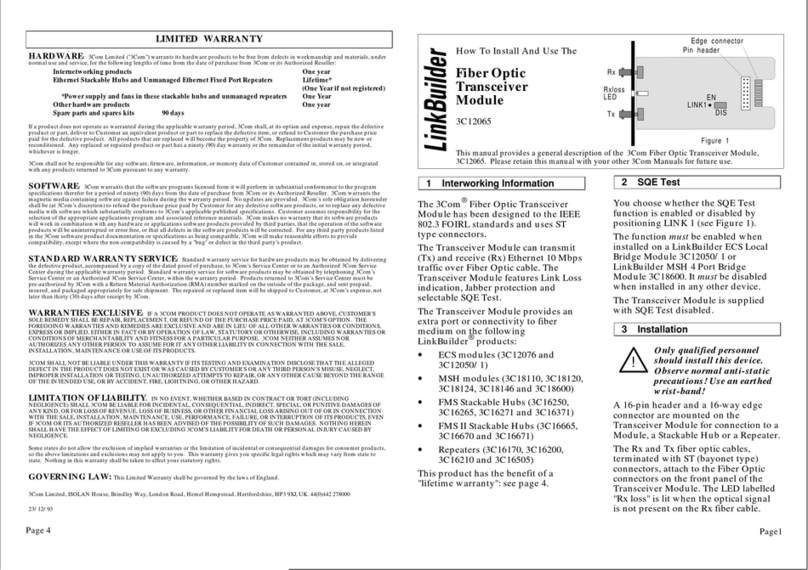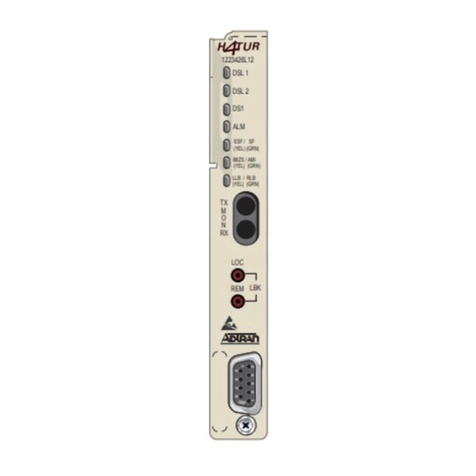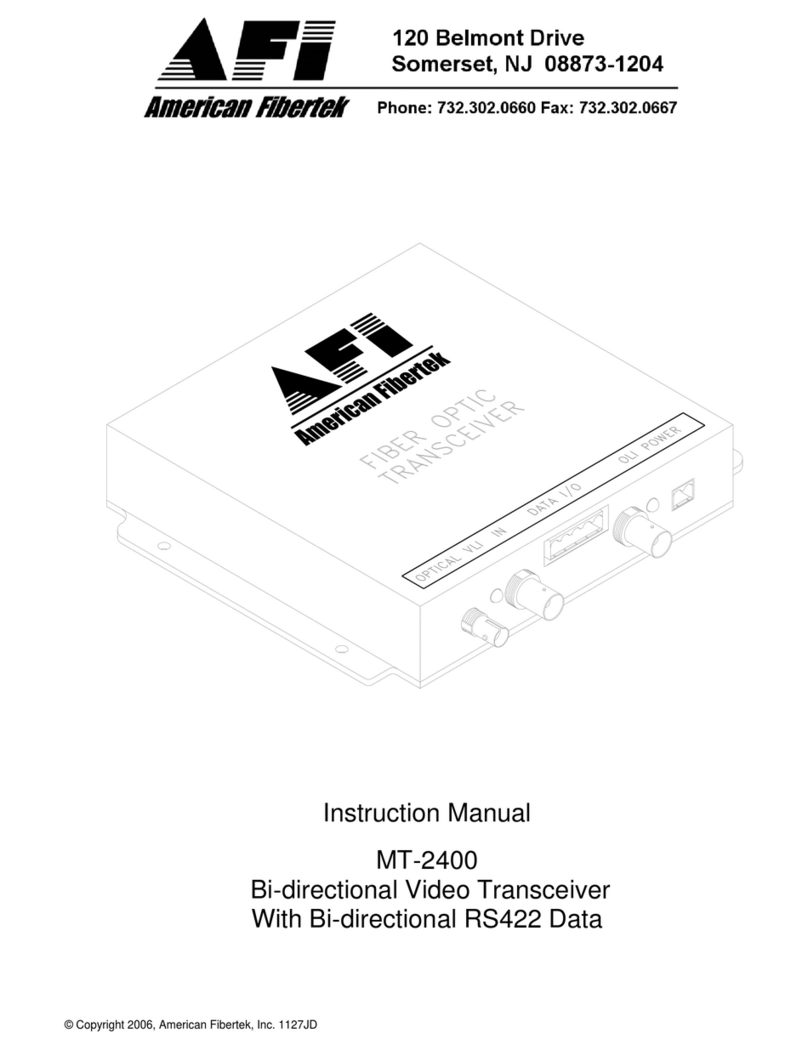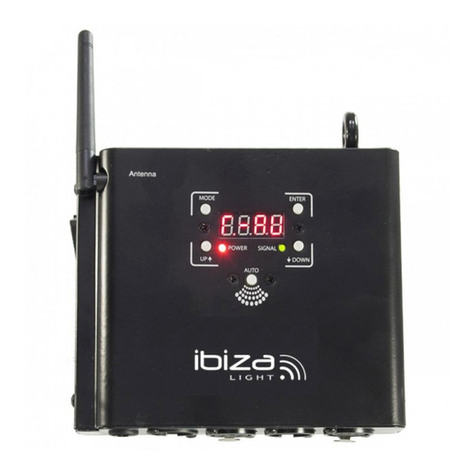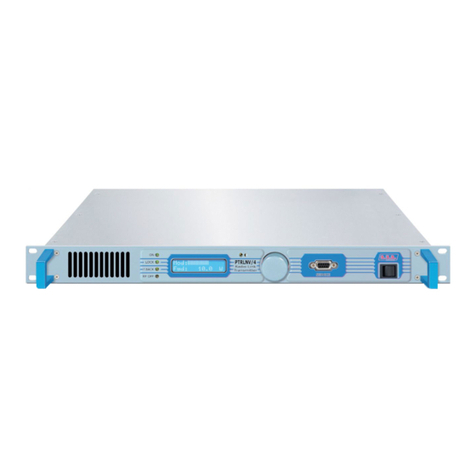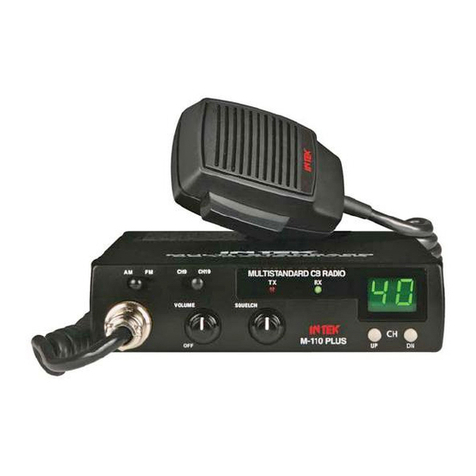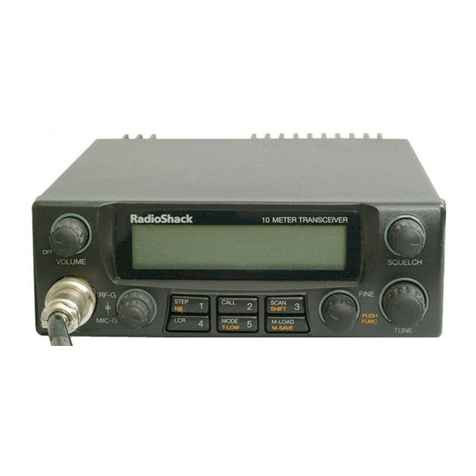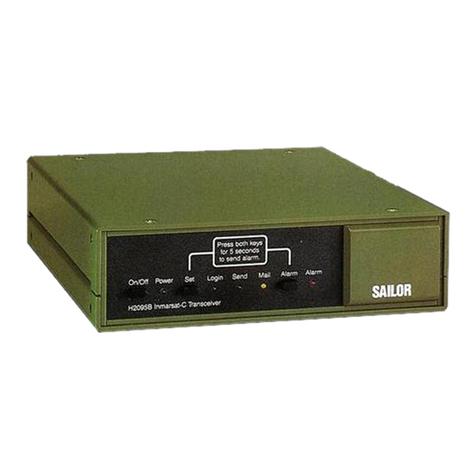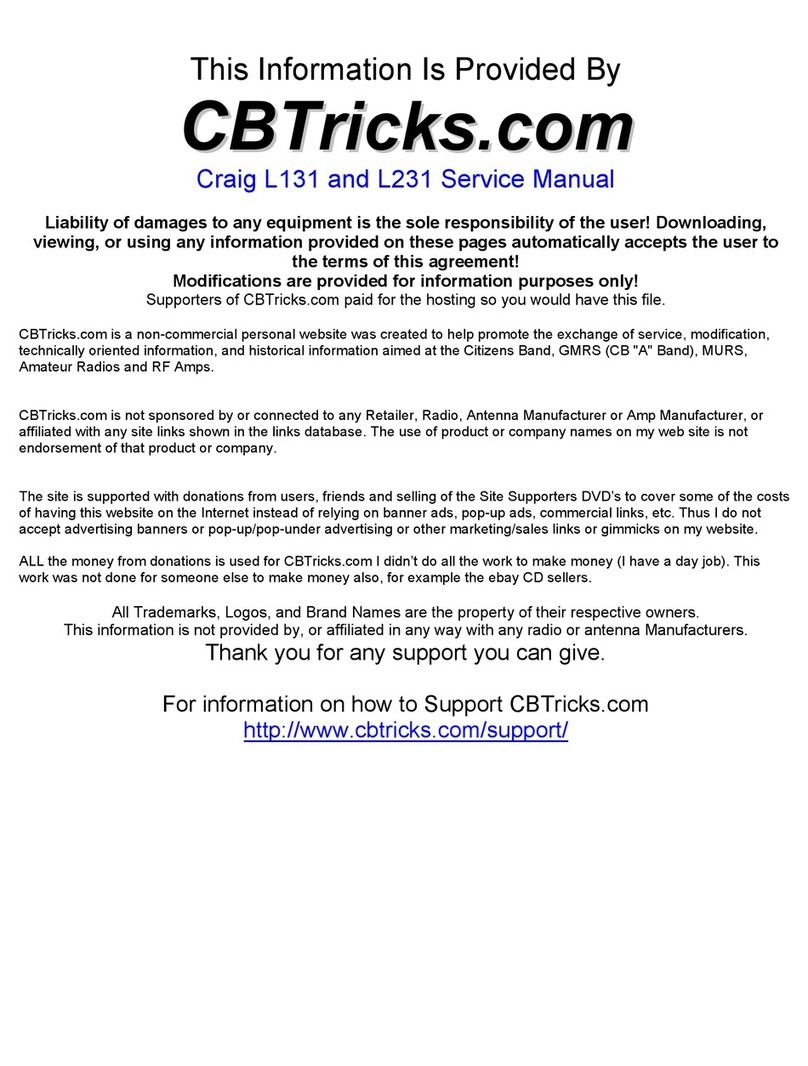Icom IC-A4 User manual

iA4
VHF AIR BAND TRANSCEIVER
INSTRUCTION MANUAL
This device complies with Part 15 of the
FCC Rules. Operation is subject to the
condition that this device does not cause
harmful interference.
IC-A4#01 IM 01.12.5 5:14 PM Page a (1,1)

i
FOREWORD
READ ALL INSTRUCTIONS carefully and completely
before using the transceiver.
SAVE THIS INSTRUCTION MANUAL —This in-
struction manual contains important operating instructions for
the IC-A4.
EXPLICIT DEFINITIONS
The explicit definitions below apply to this instruction manual.
CAUTIONS
RWARNING! NEVER hold the transceiver so that the
antenna is very close to, or touching exposed parts of the
body, especially the face or eyes, while transmitting. The
transceiver will perform best if the microphone is 5 to 10 cm
away from the lips and the transceiver is vertical.
RWARNING! NEVER operate the transceiver with a
headset or other audio accessories at high volume levels.
Hearing experts advise against continuous high volume op-
eration. If you experience a ringing in your ears, reduce the
volume level or discontinue use.
NEVER connect the transceiver to an AC outlet or to a
power source of more than 16 V DC. Such a connection will
damage the transceiver.
NEVER connect the transceiver to a power source that is
DC fused at more than 5 A. Accidental reverse connection will
be protected by this fuse, higher fuse values will not give any
protection against such accidents and the transceiver will be
ruined.
NEVER attempt to charge alkaline or dry cell batteries. Be-
ware that external DC power connections will charge batteries
inside the battery case. This will damage not only the battery
case but also the transceiver.
WORD DEFINITION
RWARNING Personal injury, fire hazard or electric shock
may occur.
CAUTION Equipment damage may occur.
NOTE If disregarded, inconvenience only. No risk
of personal injury, fire or electric shock.
FCC caution: Changes or modifications to this transceiver, not
expressly approved by Icom Inc., could void your authority to
operate this transceiver under FCC regulations.
IC-A4#01 IM 01.12.5 5:14 PM Page b (1,1)

ii
DO NOT push the PTT when not actually desiring to trans-
mit.
DO NOT allow children to play with any radio equipment
containing a transmitter.
DO NOT operate the transceiver near unshielded electrical
blasting caps or in an explosive atmosphere.
AVOID using or placing the transceiver in direct sunlight or
in areas with temperatures below –10°C or above +60°C.
The use of non-Icom battery packs/chargers may impair
transceiver performance and invalidate the warranty.
Even when the transceiver power is OFF, a slight current still
flows in the circuits. Remove the battery pack or case from
the transceiver when not using it for a long time. Otherwise,
the battery pack or installed dry cell batteries will become ex-
hausted.
SUPPLIED ACCESSORIES
Accessories included with the transceiver: Qty.
qAntenna .......................................................................... 1
wBelt clip ........................................................................... 1
eHandstrap........................................................................ 1
rBattery pack or battery case with Ni-Cd batteries .......... 1
tWall charger* .................................................................. 1
*The battery pack (BP-195) or battery case may differ depending
on version. Some versions do not include a battery pack and wall
charger.
+_
qw e
t
r
IC-A4#01 IM 01.12.5 5:14 PM Page c (1,1)

FOREWORD ........................................................................ i
EXPLICIT DEFINITIONS ..................................................... i
CAUTIONS .......................................................................... i
SUPPLIED ACCESSORIES................................................. ii
TABLE OF CONTENTS ...................................................... iii
1 ACCESSORY ATTACHMENT ....................................... 1
2 PANEL DESCRIPTION ............................................ 2 – 4
■Panel description ................................................... 2 – 3
■Function display .......................................................... 4
3 BASIC OPERATION ................................................ 5 –7
■Receiving and transmitting ......................................... 5
■Setting squelch level ................................................... 6
■Side tone function ....................................................... 6
■Lock function .............................................................. 6
■Display backlighting .................................................... 6
■Low battery indicator .................................................. 6
■Dial select function ..................................................... 7
4 SCAN OPERATION ...................................................... 8
■Memory (lockout) scan ............................................... 8
■VFO (full) scan ............................................................ 8
5 MEMORY PROGRAMMING .................................. 9 – 10
■Programming a memory channel ............................... 9
■Memory names ......................................................... 10
6 OTHER FUNCTIONS .................................................. 11
■Initial set mode .......................................................... 11
■Resettng the CPU ..................................................... 11
7 BATTERY PACKS ................................................ 12 – 14
■Charging precautions ............................................... 12
■Battery pack charging ............................................... 12
■About the battery pack .............................................. 14
■Installing batteries in the battery case ...................... 14
8 CLONING .................................................................... 15
9 TROUBLESHOOTING ................................................ 16
10 SPECIFICATIONS ....................................................... 17
11 OPTIONS ..................................................................... 18
iii
TABLE OF CONTENTS
IC-A4#01 IM 01.12.5 5:14 PM Page d (1,1)

1
1
ACCESSORY ATTACHMENT
DAntenna
CAUTION: Transmitting without an
antenna may damage the transceiver.
Insert the supplied antenna into the an-
tenna connector and screw down the an-
tenna as shown at right.
Keep the jack cover attached when jacks
are not in use to avoid bad contacts from
dust and moisture.
DBattery pack replacement
To remove:
Push and hold the bat-
tery release downwards,
then pull the battery pack
upwards as shown at
right.
To attach:
Mate the notched ends of the battery pack and the trans-
ceiver, and push the battery pack until it clicks into place.
DBelt clip
Conveniently attaches to your belt.
To attach:
Slide the belt clip into the plastic loop on the back of the bat-
tery case/pack.
To remove:
Push the top of the belt clip towards the transceiver and at
the same time, push it downward and free of the plastic loop.
IC-A4#01 IM 01.12.5 5:14 PM Page 1 (1,1)

■Panel description qVOLUME CONTROLS [VOL] (p. 5)
Turns power ON and adjusts the audio level.
wPTT SWITCH [PTT] (p. 5)
Push and hold to transmit; release to receive.
eCHANNEL UP/DOWN SWITCHES [Y]/[Z]
➥Push to select the operating channel or frequency. (p. 5)
➥Select item conditions in set mode.
rLOCK SWITCH [ ]
➥Push and hold 2 sec. to toggle the key lock function ON
or OFF. (p. 6)
- “ ” appears on the display.
tVFO/MEMORY SWITCH [V/M]
➥Push to select VFO mode or memory mode. (pgs. 5, 8)
- “X” appears when memory mode is selected.
- The transceiver has 19 memory channels.
yMEMORY WRITE SWITCH [MW]
➥Push and hold for 5 sec. to write information into mem-
ory channels. (p. 9)
uSCAN SWITCH [SCAN]
➥Starts and stops the scan function:
VFO mode: VFO scan function.
MEMORY mode: Memory channel scan function. (p. 10)
2
2PANEL DESCRIPTION
q
w
e
r
t
y
u
i
o
!0
!1
!2
!3
!4
IC-A4#01 IM 01.12.5 5:14 PM Page 2 (1,1)

3
2
PANEL DESCRIPTION
➥When memory mode is selected, this switch sets the dis-
played channel as a scan lock-out channel when pushed
for 2 sec. (p. 8)
- “SKIP” appears on the display.
iSQUELCH SWITCH [SQL]
➥Push and hold to open the squelch. (p. 6)
➥While pushing [SQL], push [Y]/[Z] to select the squelch
level. (p. 6)
- 9 squelch levels and squelch open are available.
oFUNCTION DISPLAY (p. 4)
!0 TRANSMIT INDICATOR
Lights red while transmitting.
!1 EXTERNAL DC POWER JACK [CHARGE]
Connect a 12 to 16 V DC power source using the optional
cables, CP-12L or OPC-254L, to charge the attached bat-
tery pack; or connect the BC-110V wall charger for charg-
ing.
CAUTION: This connection is for charging ONLY.
Power to the transceiver must be turned OFF during
charging.
!2 SPEAKER/MICROPHONE
!3 EXTERNAL SPEAKER AND MICROPHONE JACKS
[SP/MIC]
➥Connect an optional speaker-microphone or headset, if
desired. The internal microphone and speaker will not
function when either is connected. (See p. 18 for a list of
available options.)
➥Side tone function is available when an optional head-
set adapter is connected. (pgs. 6, 18)
!4 ANTENNA CONNECTOR (p. 1)
Connects the supplied antenna.
IC-A4#01 IM 01.12.5 5:14 PM Page 3 (1,1)

4
2PANEL DESCRIPTION
■Function display
qMEMORY MODE INDICATOR (p. 9)
Appears when memory mode is selected.
wLOCK INDICATOR (p. 6)
Indicates that the lock function is in use.
eLOW BATTERY INDICATOR
➥Appears when the battery is nearing exhaustion.
➥Appears and flashes when battery replacement is nec-
essary.
rFREQUENCY DISPLAY (p. 11)
➥Shows the operating frequency.
➥Shows the channel name when the memory name func-
tion is selected. (p. 10)
tBUSY INDICATORS
➥“BUSY” appears when receiving a signal or when the
squelch is open.
yMEMORY LOCKOUT INDICATOR
➥”SKIP” appears when the memory channel is set as
lockout channel.
uMEMORY CHANNEL INDICATOR
➥Shows the memory channel number.
➥When the transceiver output power increases above a
specified level, a protection circuit stops the transmitting,
then “--” appears on the display instead of the memory
channel number. Release [PTT] then push it again to
continue transmitting.
MR
SKIP
IC-A4#01 IM 01.12.5 5:14 PM Page 4 (1,1)

5
3
BASIC OPERATION
■Receiving and transmitting
CAUTION: Transmitting without an antenna may dam-
age the transceiver.
qRotate [VOL] clockwise to turn power ON, then set to the
10 o’clock position.
wPush [V/M] to select memory mode or VFO mode.
eSelect the desired memory channel or VFO frequency with
the [Y]/[Z] keys.
•When receiving a signal, “BUSY” appears and audio is emitted
from the speaker.
• Further adjustment of [VOL] may be necessary at this point.
• Push [SQL] to toggle the squelch function ON and OFF. (p. 6)
•When the dial select function is selected, each push incre-
ments/decrements the frequency either 100 kHz or 1 MHz. (p. 7)
rPush and hold [PTT] to transmit, then speak into the mi-
crophone.
• Transmit indicator lights.
tRelease [PTT] to receive.
ïMemory ➾VFO
Memory channel contents can be moved to VFO .
qSelect memory channel to be transferred:
➥Push [V/M] to select memory mode, if necessary.
➥Push [Y] or [Z] to select the memory channel.
wPush [V/M] key for 2 sec. to transfer the memory contents
to VFO.
- VFO mode is selected
NOTE:
•Only frequency data is transferred even if the memory
channel has a memory name.
•When the preprogrammed memory frequency is outside
the range of the preprogrammed VFO edges, an error
beep tone sounds and no data is transferred.
qSet volume
w[SQL] switch
rSpeak into
microphone
rPush to transmit
tRelease to
receive
wSelect channel
or frequency
IC-A4#01 IM 01.12.5 5:14 PM Page 5 (1,1)

6
3BASIC OPERATION
■Setting squelch level
The transceiver has a noise squelch circuit to mute undesired
noise while receiving no signal.
➥To open the squelch:
Push and hold [SQL] to open the squelch. This is useful to
listen to weak signals that do not open the squelch.
- “BUSY” appears on the display.
➥To close the squelch:
Release [SQL] to close the squelch.
DSetting the squelch level
qWhile pushing [SQL], push [Y] or [Z] to select the squelch
level.
- ‘Sq 1’ is loose squelch and ‘Sq 9’ is tight squelch. (Initial
level is 3.)
- ‘oPEn’ indicates that the squelch circuit is turned off.
wRelease [SQL] to return to regular operation.
■Side tone function
When using an optional headset, such as those from the
David Clark Co. via the OPC-752 HEAD SET ADAPTOR, the
transceiver outputs your transmitted voice to the headset for
monitoring. (p. 18)
■Lock function
The lock function prevents accidental channel changes and
accidental function access. [PTT] and [SQL] still function
while the lock function is in use.
➥Push [ ]for 2 sec. to toggle the lock function ON and OFF.
■Display backlighting
Display backlighting automatically turns on when a key is
pushed.
■Low battery indicator
Low battery indicator appears
when the battery power has de-
creased to a specified level.
MR
“”appears when the
lock function is in use.
MR
SKIP
IC-A4#01 IM 01.12.5 5:14 PM Page 6 (1,1)

7
3
BASIC OPERATION
■Dial select function
Use the dial select function to adjust the tuning behavior of
the [Y]/[Z] keys—use 1 MHz tuning when you want to
change the frequency in large increments; use regular tuning
when you want to change the frequency in smaller incre-
ments.
qPush [V/M] to select VFO
mode.
wPush [V/M] for 2 sec. one or
more times to select the de-
sired tuning increment.
- 1 MHz tuning, 100 kHz tun-
ing or regular tuning steps
can be selected. (see dia-
grams at right)
ePush any key to return to nor-
mal operation.
NOTE: Large tuning steps should be used only when you
want to change the frequency in large increments please se-
lect regular tuning steps for normal operation.
1 MHz tuning selected
100 kHz tuning selected
Regular tuning selected
IC-A4#01 IM 01.12.5 5:14 PM Page 7 (1,1)

8
4SCAN OPERATION
■Memory (lockout) scan
Memory scan repeatedly scans all programmed memory
channels, except those set as lockout channels.
qPush [V/M] to select memory mode, if necessary.
• “ ” appears.
wPuch [SCAN] to start scan.
- To change the scan direction, push [Y] or [Z].
ePush [SCAN] again to stop the scan.
MR
MEMORY LOCKOUT(SKIP) SCAN
SKIP
SKIP
Mch 1 Mch 7
Mch 2 Mch 4
Mch 3 Mch 5 Mch 6
Mch 8
Mch 19 Mch 11 Mch 10 Mch 9
■VFO (Full) scan
VFO scan repeatedly scans between the VFO’s lowest
frequency and its highest frequency.
- To change the scan direction, push [Y] or [Z] during
scanning.
DScan resume condition
When a signal is received during scanning, the scan pauses
on the signal until it disappears, then resumes.
VFO SCAN (Full scan)
Scan
Jump
Start highest
frequency
lowest
frequency
IC-A4#01 IM 01.12.5 5:14 PM Page 8 (1,1)

9
5
MEMORY PROGRAMMING
■Programming a memory
channel
The transceiver has 19 memory channels for storage of often
-used frequencies.
qPush [V/M] to select VFO
mode, if necessary.
wPush [Y] or [Z] key to select
the desired frequency.
• Push [V/M] key one or more
times to use the dial select
function, if desired.
ePush [MW] for 5 sec. to enter
memory programming mode.
•“ ” and memory channel
number appear.
rPush [Y] or [Z] to select the
desired memory channel
number.
tPush [MW] for 2 sec. to pro-
gram the information into the
channel and return to VFO
mode.
MR
MR
MR
DSetting lockout channels
In order to speed up the scan interval, you can set memory
channels you don’t wish to scan as lockout channels.
qPush [V/M] to select memory mode, if necessary.
• “ ” appears.
wPush [Y] or [Z] to select a memory channel to set as a
lockout channel.
ePush [SCAN] for 2 sec. to toggle the lockout setting
ON/OFF.
•“SKIP” appears when the chan-
nel is set as a lockout channel.
•If memory channel scan is acci-
dentally started, push [SCAN] to
stop it.
MR
MR
SKIP
Memory channel 15 is
set as a lockout channel.
IC-A4#01 IM 01.12.5 5:14 PM Page 9 (1,1)

10
5MEMORY PROGRAMMING
■Memory names
ïProgramming memory names
qSelect the memory channel to be programmed:
➥Push [V/M] to select memory mode.
➥Push [Y] or [Z] to select the memory channel.
wPush [M/W] for 5 sec. to enter memory name writing mode.
• The first character of the name flashes.
ePush [SCAN] or [SQL] as many times as necessary to
enter the desired name.
• To erase a character, overwritet with a space (displayed as _).
•To move the cursor forwards or backwards, use [Y] or [Z].
• Push [ ] for 2 sec. to erase all characters.
rPush [M/W] to input the set name.
• Flashing stops.
•Memory channels can be programmed with names of up to 5
characters in length.
•When no name is programmed, the display shows the operating
frequency.
• The following characters can be used in names:
➥0 to 9, A to Z (capitals), (space), “-”, #, $, &, (, ), “,”, •, /,
<, >, =, “, ‘, ?, ! and @.
MR MR MR
[EXAMPLE]: Setting the name to “TOWER”.
SCAN +
MW MW
SQL
or or
MR
for 5 sec. for 2 sec.
IC-A4#01 IM 01.12.5 5:14 PM Page 10 (1,1)

11
6
OTHER FUNCTIONS
■Initial set mode
Initial set mode is accessed at power ON and allows you to
set seldom-changed settings, in this way you can “customize”
transceiver operations to suit your preferences and operating
style.
DEntering initial set mode
qWhile pushing [V/M] + [ ], turn power ON.
•The transceiver enters initial set mode and “mn”, “bP” or “St” ap-
pears on the display.
wPush[Y] or [Z] one or more times to select the desired
item as described below and at right.
ePush [ ] to select the desired condition.
rPush [MW] or [PTT] to exit initial set mode and select the
previous operating mode.
DMemory names
This item allows you to display a
memory name instead of fre-
quency.
•When a memory channel has
not been programmed with a
name, frequency indication ap-
pears instead.
DBeep tones ON/OFF
Confirmation beep tones nor-
mally sound when you push a
key. These can be turned ON or
OFF as you prefer.
DSide tones ON/OFF
When using an optional headset
such as those from the David
Clark Co. via the adapter, the
transceiver outputs your trans-
mitted voice to the headset for
monitoring.
•Optional OPC-752 HEADSET
ADAPTER is required.
■Resetting the CPU
Reset the CPU before operating the transceiver for the first
time, or when the internal CPU malfunctions.
➥While pushing [V/M] + [MW] + [SCAN], turn power ON to
reset the transceiver.
•“CLEAR” appears briefly to indicate the CPU has been reset.
]
IC-A4#01 IM 01.12.5 5:14 PM Page 11 (1,1)

■Charging
precautions
NEVER attempt to charge dry cell bat-
teries. This will cause internal liquid
leakage and damage the battery case
and transceiver.
NEVER connect two or more chargers
at the same time.
Charging may not occur under temper-
atures of 10°C (50°F) or over tempera-
tures of 40°C (104°F).
When using BC-119: If the charge
indicator flashes orange, vehicle bat-
tery voltage is low and charging is
not possible. Check the vehicle bat-
tery voltage in this case. If the
charge indicator flashes red, there
may be a problem with the battery
pack (or charger). Re-insert the bat-
tery pack or contact your dealer.
■Battery pack
charging
The BP-195 or BP-196
BATTERY PACK
includes rechargeable Ni-Cd batteries
and can be charged approx. 300 times.
Charge the battery pack before first op-
erating the transceiver or when the bat-
tery pack becomes exhausted.
If you want to be able to charge the bat-
tery pack more than 300 times, the fol-
lowing points should be observed:
1. Avoid overcharging. The charging pe-
riod should be less than 48 hours.
2.Use the battery until it becomes al-
most completely exhausted under
normal conditions. We recommend
battery charging just after transmitting
becomes impossible.
D
Rapid charging with the BC-119
The optional BC-119 provides rapid
charging of battery packs.
One AD-81 and an AC adapter (may be
supplied with the BC-119 depending on
version) are additionally required.
• Charging periods: 1.5 hours (w/BP-195)
2 hours (w/BP-196)
12
7BATTERY PACKS
Turn power
OFF.
BC-119+
AD-81
BC-119+
AD-81
Check orientation
for correct charging.
(Packed together
as the AD-81.)
Check orientation
for correct charging.
(Packed together
as the AD-81.)
IC-A4#01 IM 01.12.5 5:14 PM Page 12 (1,1)

13
7
BATTERY PACKS
DMultiple charging with the BC-121
The optional BC-121 allows up to 6 battery packs to be
charged simultaneously.
Six AD-81’s and an AC adapter (may be supplied with the
BC-121 depending on version) are additionally required.
•Charging periods: 1.5 hours (w/BP-195)
2 hours (w/BP-196)
DRegular charging
qAttach the battery pack to the transceiver.
wBe sure to turn the transceiver power OFF.
eConnect the AC adapter (BC-110A/D/V) or optional cable
(CP-12L or OPC-254L) as shown below.
•Charging periods: 10 hours (w/BP-195)
15 hours (w/BP-196)
IC-A4 with
attached
battery case
(pack)
BC-110A/D/V
CP-12L
(optional)
OPC-254L
(optional)
To a 12 to
16 V DC
power source
To
[CHARGE]
white
black
MULTI-CHARGER
AC adapter
(not supplied with some versions)
Charge indicator
(each indicator function
independently)
IC-A4#01 IM 01.12.5 5:14 PM Page 13 (1,1)

14
7BATTERY PACKS
■About the battery pack
DOperating period
Depending on the attached battery pack, the operating period
of the transceiver varies. Refer to the last page for battery
pack specifications.
DBattery pack life
If your battery pack seems to have no capacity even after
being fully charged, completely discharge it by leaving the
power ON overnight. Then, fully charge the battery pack
again.
If the battery pack still does not retain a charge (or very little),
a new battery pack must be purchased.
DRecycling information (U.S.A only)
The product that you have purchased may
contain a rechargeable battery. The battery
is recyclable. At the end of its life, under var-
ious state and local laws, it may be illegal to
dispose of this battery into the municipal
waste stream. Call 1-800-8-BATTERY for
battery recycling options in your area or contact your dealer.
■Installing batteries in the
battery case
When using a battery case, install 8 AA (R6) size Ni-Cd or al-
kaline batteries as illustrated below.
qRemove the bat-
tery case from the
transceiver.
wInstall 8 ×AA (R6)
size Ni-Cd or alka-
line batteries.
•Be sure to observe
the correct polarity.
●NEVER connect DC power to the transceiver when in-
stalling dry cell or alkaline batteries. Such a connection will
damage the transceiver.
●Be careful of battery overcharging. When operating via ex-
ternal DC power, installed batteries are simultaneously
charged.
●Keep battery contacts clean. It’s a good idea to clean bat-
tery terminals once a week.
RBRC
RBRC
Ni-
Cd
IC-A4#01 IM 01.12.5 5:14 PM Page 14 (1,1)

CLONING
15
8
Cloning allows you to quickly and easyly
transfer the programmed contents from
one transceiver to another transceiver, or,
data from PC to a transceiver using the optional EX-2119
cloning software.
DTransceiver to transceiver cloning
qConnect the OPC-474 CLONING CABLE with adapter plugs to
the [SP] jack of the master and slave transceivers.
•The master transceiver is used to send data to the slave trans-
ceiver.
wWhile pushing [Y] + [Z] + [V/M], turn power ON to enter
cloning mode (master transceiver only—power ON only for
slave transceiver).
•“CLonE”appears and the
transceivers enter the clone
standby condition.
ePush [PTT] on the master
transceiver.
•“CLoUt”appears in the mas-
ter transceiver’s display.
•“CL in”appears automati-
cally in the slave trans-
ceiver’s display.
eWhen cloning is finished, turn
power OFF, then ON again to
exit cloning mode.
DCloning using PC
Data can be cloned to and from a PC (IBM compatible) using
the optional EX-2119 CLONING SOFTWARE and the optional OPC-
478 CLONING CABLE. Consult the EX-2119 CLONING SOFTWARE HELP
message for details.
DCloning error
NOTE: DO NOT push [PTT] on the slave transceiver dur-
ing cloning. This will cause a cloning error.
When the display at right ap-
pears, a cloning error has oc-
curred.
In this case, both transceivers automatically return to the
clone standby condition and cloning must be repeated.
]
IC-A4#01 IM 01.12.5 5:14 PM Page 15 (1,1)

16
9TROUBLESHOOTING
If your transceiver seems to be malfunctioning, please check
the following points before sending it to a service center.
POSSIBLE CAUSE SOLUTION REF.
No power comes on. •The battery is exhausted.
•Bad connection to the battery pack.
•Recharge the battery pack.
•Check the connection to the
transceiver.
pgs. 12,
14
No sound comes from the
speaker.
•Squelch level is too deep.
•Volume level is too low.
•Set squelch to the threshold point.
•Set [VOL] to a suitable level.
pgs. 5, 6
Transmitting impossible. •Some channels are receive only.
•The battery is exhausted.
•Change channels.
•Recharge the battery pack.
p. 5
p. 12
The displayed channel
cannot be selected.
•Lock function is activated. •Push for 2 sec. to cancel the
function.
p. 6
Scan does not start. •All memory channels are programmed
as lockout channels.
•Cancel the lockout settings of
desired channels.
p. 9
No beep sounds. •Beep tones turned OFF. •Turn the beep tone ON in set mode. p. 11
PROBLEM
IC-A4#01 IM 01.12.5 5:14 PM Page 16 (1,1)
Other manuals for IC-A4
2
Table of contents
Other Icom Transceiver manuals
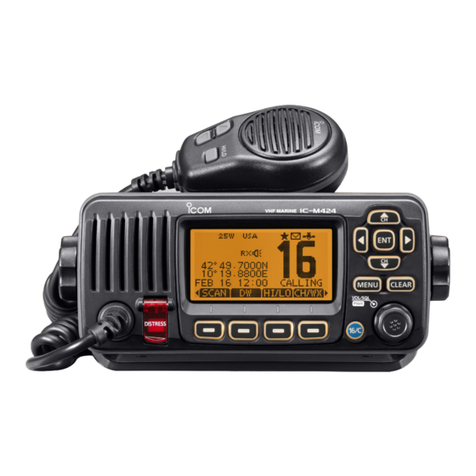
Icom
Icom IC-M423 User manual
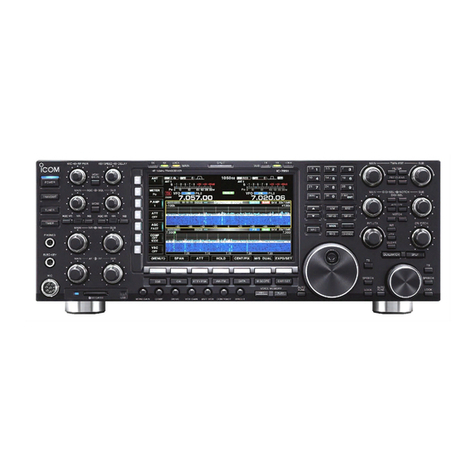
Icom
Icom IC-7851 Building instructions

Icom
Icom IC-12GAT User manual
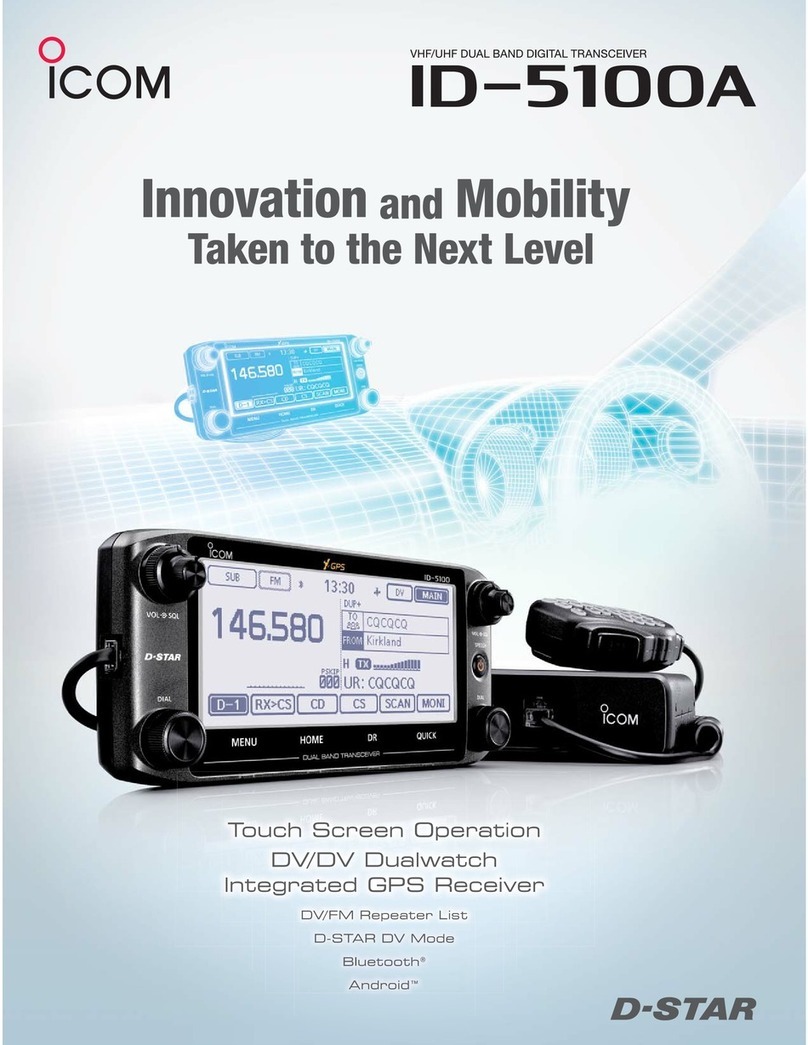
Icom
Icom ID-5100A User manual
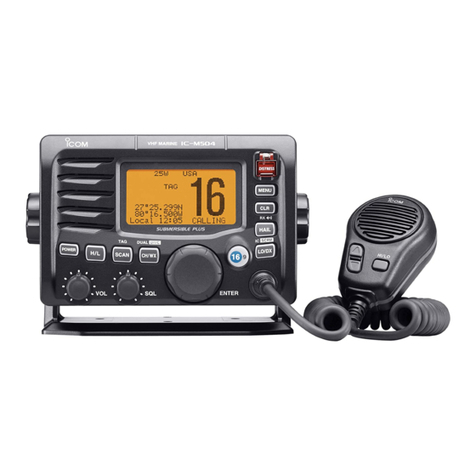
Icom
Icom IC-M504 User manual
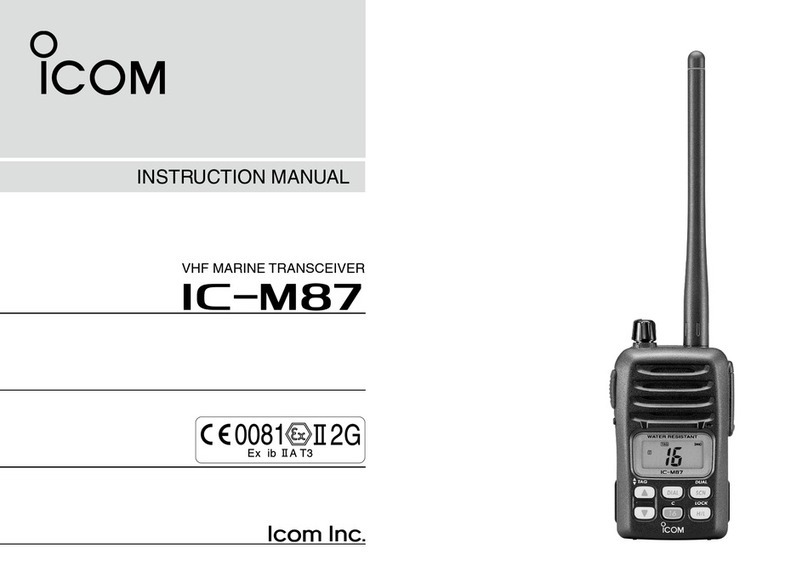
Icom
Icom IC-M87 User manual
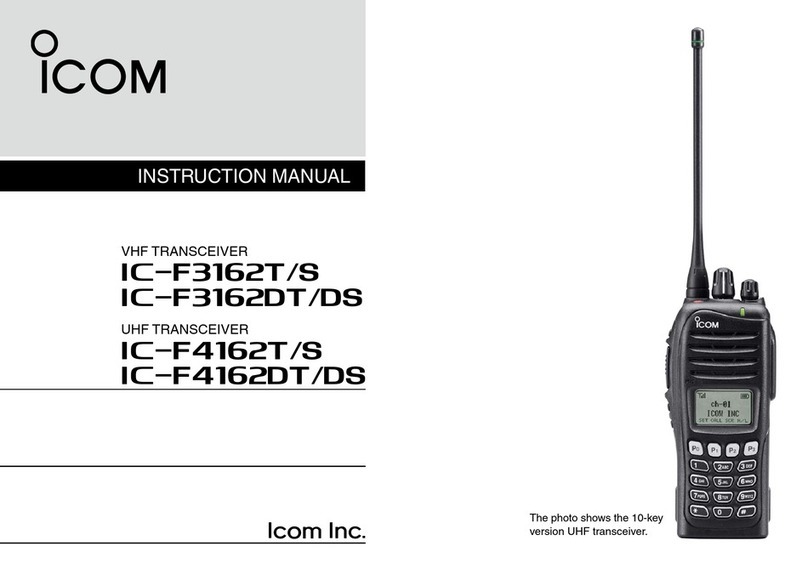
Icom
Icom ic-F3162T/S User manual
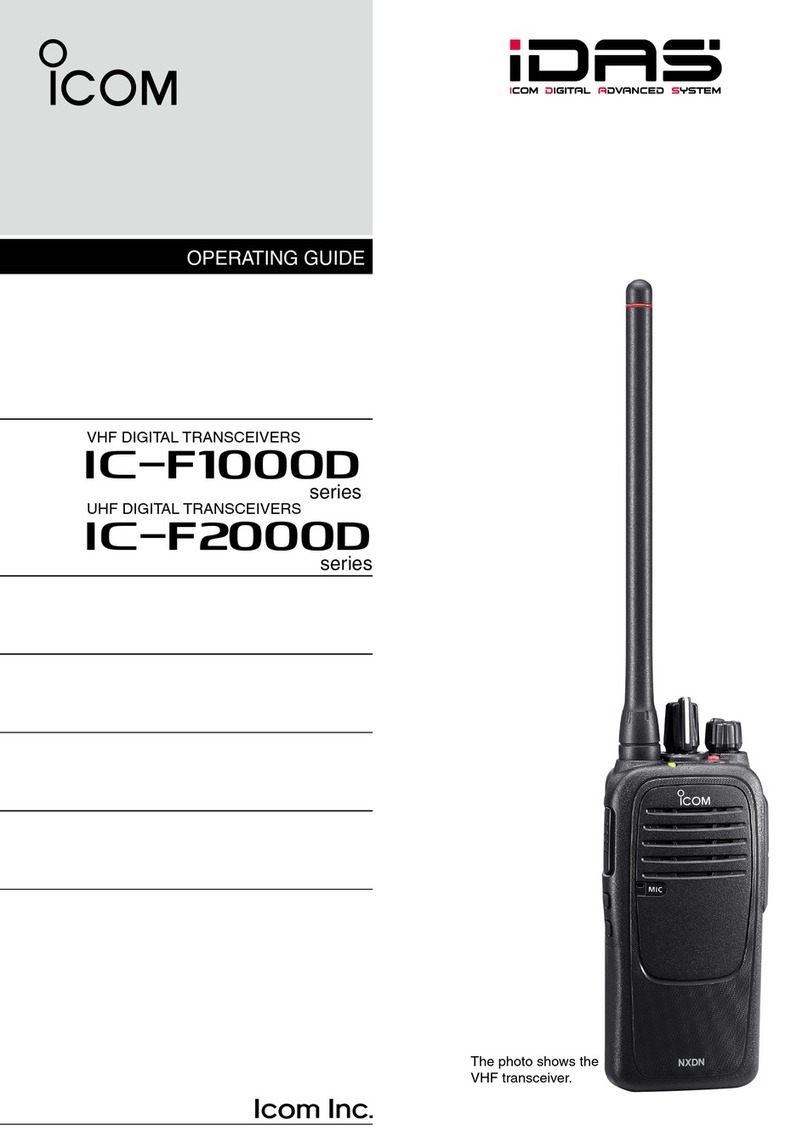
Icom
Icom ic-f1000d series User manual
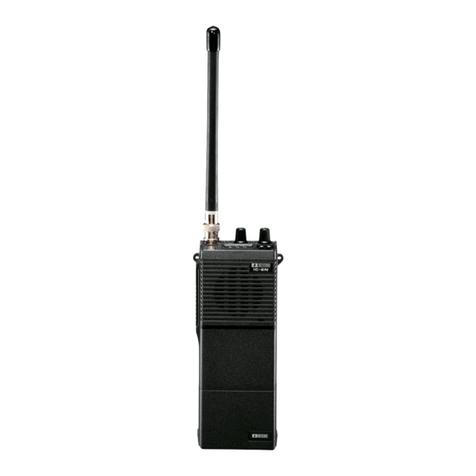
Icom
Icom IC-2A User manual
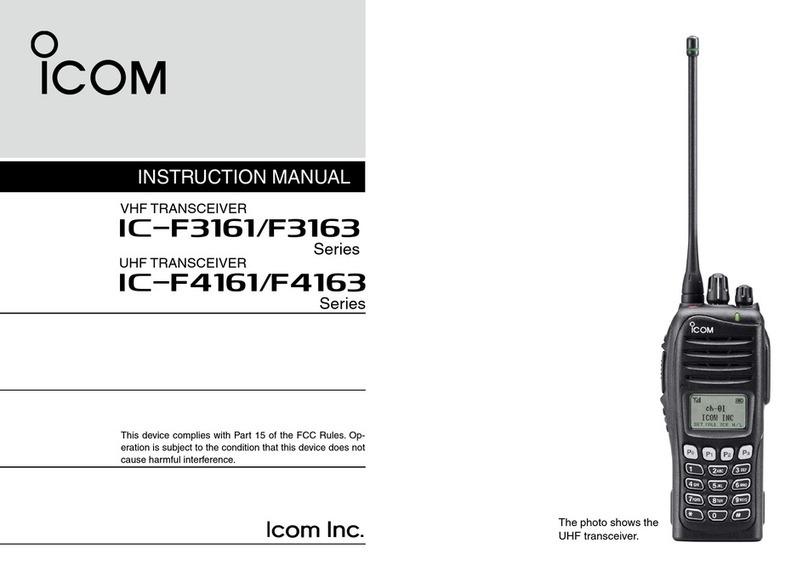
Icom
Icom IC-iF3161 User manual
